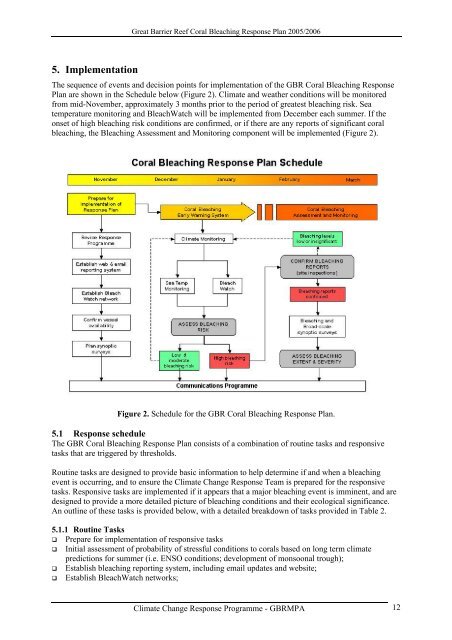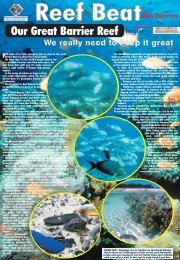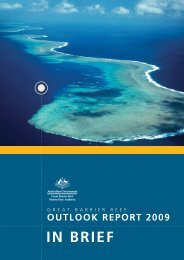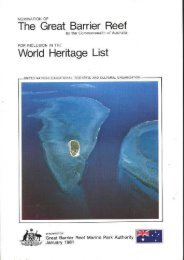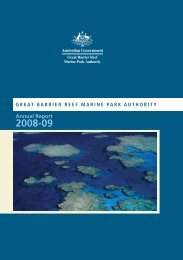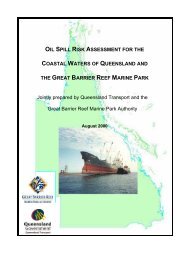Coral Bleaching Response Plan - Great Barrier Reef Marine Park ...
Coral Bleaching Response Plan - Great Barrier Reef Marine Park ...
Coral Bleaching Response Plan - Great Barrier Reef Marine Park ...
You also want an ePaper? Increase the reach of your titles
YUMPU automatically turns print PDFs into web optimized ePapers that Google loves.
<strong>Great</strong> <strong>Barrier</strong> <strong>Reef</strong> <strong>Coral</strong> <strong>Bleaching</strong> <strong>Response</strong> <strong>Plan</strong> 2005/2006<br />
5. Implementation<br />
The sequence of events and decision points for implementation of the GBR <strong>Coral</strong> <strong>Bleaching</strong> <strong>Response</strong><br />
<strong>Plan</strong> are shown in the Schedule below (Figure 2). Climate and weather conditions will be monitored<br />
from mid-November, approximately 3 months prior to the period of greatest bleaching risk. Sea<br />
temperature monitoring and BleachWatch will be implemented from December each summer. If the<br />
onset of high bleaching risk conditions are confirmed, or if there are any reports of significant coral<br />
bleaching, the <strong>Bleaching</strong> Assessment and Monitoring component will be implemented (Figure 2).<br />
Figure 2. Schedule for the GBR <strong>Coral</strong> <strong>Bleaching</strong> <strong>Response</strong> <strong>Plan</strong>.<br />
5.1 <strong>Response</strong> schedule<br />
The GBR <strong>Coral</strong> <strong>Bleaching</strong> <strong>Response</strong> <strong>Plan</strong> consists of a combination of routine tasks and responsive<br />
tasks that are triggered by thresholds.<br />
Routine tasks are designed to provide basic information to help determine if and when a bleaching<br />
event is occurring, and to ensure the Climate Change <strong>Response</strong> Team is prepared for the responsive<br />
tasks. Responsive tasks are implemented if it appears that a major bleaching event is imminent, and are<br />
designed to provide a more detailed picture of bleaching conditions and their ecological significance.<br />
An outline of these tasks is provided below, with a detailed breakdown of tasks provided in Table 2.<br />
5.1.1 Routine Tasks<br />
Prepare for implementation of responsive tasks<br />
Initial assessment of probability of stressful conditions to corals based on long term climate<br />
predictions for summer (i.e. ENSO conditions; development of monsoonal trough);<br />
Establish bleaching reporting system, including email updates and website;<br />
Establish BleachWatch networks;<br />
Climate Change <strong>Response</strong> Programme - GBRMPA 12


